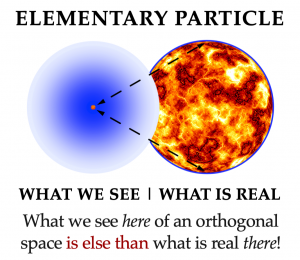Breaking the Cosmic Code: Convergetics Scientist Unveils Quantum Spaces as Real, Not Imaginary Constructs
I dedicate this work to Rafael Bombelli, who invented imaginary numbers. Without his "wild thought," there would be no concept of quantum spaces and much of today's physics would have been impossible.”
MONTREAL, QC, CANADA, August 3, 2023/EINPresswire.com/ -- While exploring the physical nature of imaginary numbers and their connection to quantum spaces, the Convergetics scientist Gene Alexandrescu discovered the mathematical dual-space, which led him hypothesize that our universe is an overarching four-dimensional spacetime manifold, as Einstein believed, but with an unexpected secret twist:— Gene Alexandrescu
Quantum spaces, which we now think of as abstract mathematical structures, are in fact real spaces embedded in, but at the same time distinct from, the space of the universe. For this reason elementary particles are dimensionless mathematical points for us and we can only perceive their fields.
In the field of mathematics, imaginary numbers have long been a subject of intrigue and fascination. Once considered as mathematical curiosities, these numbers have found remarkable applications in various branches of science and physics. One such domain where imaginary numbers play a crucial role is in the understanding of quantum spaces and the behavior of particles at the microscopic level.
Elementary particles, the fundamental constituents of all matter in this universe, exist within quantum spaces. They can only be described within quantum mechanics using complex mathematical formulations. They are not considered "imaginary" by scientists in the colloquial sense but are represented through abstract mathematical models because of their counter-intuitive properties at the quantum level. They are dimensionless and only their fields can be detected and measured. Until now, no one could provide an explanation for the physical nature of these spaces—as real matter in objective reality—or where exactly they exist within or outside the universe.
Despite being dimensionless, these particles exhibit various physical properties such as mass, electric charge, and spin. While mass and electric charge are familiar concepts in classical physics, spin is a purely quantum mechanical property that represents the particle's angular momentum. However, unlike a spinning top, a particle's spin does not signify literal rotation. Instead, it manifests as a magnetic moment and influences the particle's quantum behavior.
Observers looking at a particle "from here," i.e. from our universe, or "from outside" the particle, perceive it as a dimensionless mathematical point. Moreover, what we perceive as the particle's field is actually its boundary, which extends across the entire space of our universe.
This dual perspective applies not only to elementary particles, but also to other spaces, regardless of their actual size. For this reason it is impossible to estimate the size of particles when we look at them "from the outside." As one might reasonably expect, it is equally impossible for a real observer to inhabit the space of a particle or other spaces, at least for the moment.
However, theoretical observers looking at a particle "from the inside" would perceive a physical space with finite non-zero dimensions. From a physical point of view, "absolutely anything" could exist in an orthogonal space, regardless of its size or complexity.
In simpler terms, orthogonal spaces are distinct and independent from the spacetime of the universe. They are physically embedded in the space of the universe, yet simultaneously are external from it.
The concept of orthogonality of spaces, while physical, does not represent a rotation into a spatial dimension. Rather, it is a "relativistic rotation" into a dimension corresponding to the relative velocity between the two frames. Consequently, we do not even know whether we can call it a "dimension" in the sense of the traditional physical definition of the term.
For more details on orthogonal spaces, one can see the article "The Multispace Diagram vs. the Minkowski Diagram."
Further research is needed to confirm or refute this theory, but it provides a new way of thinking about the universe that could lead to exciting discoveries.
Convergetics is the overarching science that brings together the natural sciences to gain more knowledge. The branches of science that Convergetics explores to discover the rules that govern the natural world are: Mathematics, Physics, Cosmology, Astrophysics, and Earth Sciences (Geology, Geophysics, Climatology, and Seismology). A convergent science does more than just be an overarching science. It proactively drives the analytical sciences to work in synergy by connecting the dots between all of these sciences. Simply put, it looks at the big picture of reality.
“Convergetics” comes from “convergent science” and rhymes with “mathematics” and “physics.”
Convergetics Research Center is a private research company with the goal of becoming an interdisciplinary community of researchers driven by an open-minded passion for discovering reality and its natural rules.
The center was founded in 2002 in Montreal, QC Canada by Gene Alexandrescu, who holds a Master’s degree in electronic engineering. He spent most of his professional career as a R&D engineer. Gene is a financially independent scientist who conducts scientific studies without direct affiliation to a public institution such as a college or a government research and development institution.
Read this article on the Convergetics website: https://bit.ly/3Op5dzQ
Read this article on ResearchGate's website: https://bit.ly/3DWtusd
email us here
Gene Alexandrescu
Convergetics Research Center
email us here
Visit us on social media:
Twitter
Other
Legal Disclaimer:
EIN Presswire provides this news content "as is" without warranty of any kind. We do not accept any responsibility or liability for the accuracy, content, images, videos, licenses, completeness, legality, or reliability of the information contained in this article. If you have any complaints or copyright issues related to this article, kindly contact the author above.



